Top 10 Medals

Since joining the Medal Department at Spink in May 2005 I have researched and catalogued several thousand medal lots- choosing just ten has been a far harder task than I imagined, as each medal group has its own story to tell. I wish I could have included many more. Of course there are also a number of medals that we have sold at Spink over this period that would definitely have made my top ten, apart for the fact that they were catalogued by my colleague Mark- sadly I cannot claim the credit for these! By happy coincidence my top ten lots appeared in ten different auctions, so they have been well spread out.
Undoubtedly the most unusual medal I have ever catalogued and sold is that awarded not to a sailor, soldier, or airman, but to a dog! In 1943 the People's Dispensary for Sick Animals introduced a gallantry medal, named after its founder Mrs. Maria Dickin, to be awarded to animals displaying conspicuous gallantry and devotion to duty whilst serving or associated with any branch of the Armed Forces or Civil Defence Units during World War II. In total 54 Dickin Medals were awarded between 1943 and 1949, to 32 pigeons, 18 dogs, three horses, and one cat. One of those medals was awarded to a dog called Rip, and we sold his Dickin Medal at our auction on the 24th April 2009. Rip was a stray who had been found homeless and starving in Poplar, east London, after a heavy air raid in 1940. Adopted by the local A.R.P. Warden, he acted as an unofficial rescue dog, sniffing out casualties trapped under buildings, and during the course of the War he located more than 100 air raid victims. Having never catalogued anything quite like it before, I was a little uncertain what to expect up on the rostrum, but on the day of the sale the auction room was packed to witness the sale of the brave canine's medal, and it sold for a hammer price of £21,000 (£24,250 including Premium). It is also the only medal that I have sold that has been reported in the Buffalo Central news (as well as over 100 other newspapers worldwide!)
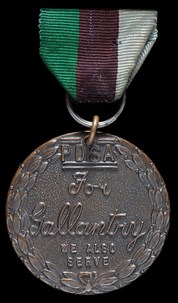 |
The next medal in my top ten is the rare China 1900 Defence of Legations Medal awarded to Sir Edward Bredon, who served as Deputy Inspector General of the Chinese Imperial Maritime Customs Service from 1898-1908 and who was present at the Defence of the Legations in Peking during the Boxer Rebellion from June to August 1900. In total just 57 China medals with the 'Defence of Legations' clasp were awarded to civilians who, together with the small Legation Guard made up out of British, American, Austrian, French, German, Italian, Japanese, and Russian troops, survived the two month siege until relieved by the main Allied force. This is a rather personal choice as it happened to be the first medal that I ever sold up on the rostrum as an Auctioneer at Spink, when it appeared (as the front cover lot) in our auction on the 20th November 2008- I was able to knock it down at the top estimate for a hammer price of £8,000 (£9,300 including Premium). By chance, this medal has subsequently reappeared at a Spink auction, and I was able to catalogue and sell it for a second time on the 21st April 2011, this time for a hammer price of £10,000 (£12,000 including Premium).
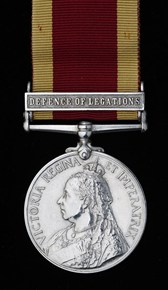 |
Since I have been at Spink I have catalogued for auction no fewer than twelve Victoria Crosses (two of which come up for sale in our April sale this year), and whilst it is tempting to include more in my top ten I have limited myself to two. The first is the single Victoria Cross to Commander, later Rear-Admiral John Bythesea, Royal Navy, who took part in the daring mission to capture Russian despatches in the Baltic on the 12th August 1854- armed only with a single flint pistol, he took three of the enemy prisoner and obtained much vital intelligence. The full story is one of daring exploits- an early 'Commando' style operation, but what makes the Cross even more special is the fact that this was only the second ever Victoria Cross to be earned. The first was lost towards the end of the 19th Century and has sadly never been seen since, and so Bythesea's is the oldest surviving Victoria Cross in existence. The single V.C. sold in our auction on the 19th April 2007 for a hammer price of £135,000 (£155,250 including Premium), a price which is still the record for a single Victoria Cross at auction.
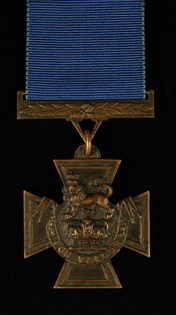 |
The second of the two Victoria Crosses which I am choosing is the Crimean 'Double Action' V.C. group of Four to Major John Knox, which was awarded to him firstly for gallantry as a Sergeant in the Scots Fusilier Guards at the Battle of Alma on the 20th September 1854, in what was the Army's first V.C. action (and approximately six weeks after Bythesea had earned his Naval V.C.), and secondly as a Lieutenant in the Rifle Brigade for the first assault on the Grand Redan at Sebastopol on the 18th June 1855. It was a great privilege and pleasure to catalogue this group, having access to the recipient's own scrapbook and diaries as a primary source of reference, and I was obviously aware at the time of the historical importance of the medal, in that it was one of the first ever Army Victoria Crosses. What I was not expecting was the huge amount of press interest that the sale of this Cross would generate. What really caught the public's imagination was the fact that Knox had lost his arm to a Russian cannon ball at Sebastopol, and the offending cannon ball, which had been picked up from the field of battle by a comrade of Knox's, was included in the lot. As a result interview requests flooded into Spink, and I appeared with the Cross and the cannon ball on the main BBC TV News, as well as giving numerous radio and newspaper interviews. Come the day of the sale, with the TV camera crews present, the original estimate was always going to be exceeded, and eventually the lot sold at our auction on the 22nd April 2010 for a hammer price of £210,000 (£252,000 including Premium), with a large number of new bidders expressing an interest in medals for the first time.
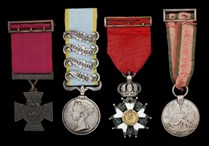 |
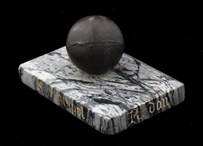 |
The next two items in my top ten are both gallantry groups, one from the First World War, and one from the Second World War. The Great War saw such huge advances in technology, and one of the most momentous of these was the development of the tank. The First World War group that I have selected is the D.S.O. Group of Five to Major A.M. Inglis, which includes the first ever Tank Operations gallantry award, for conspicuous gallantry whilst leading an advance at the Somme in his tank Crème de Menthe on the 15th September 1916, in what was the first tank attack of the War. Despite losing a wheel, Crème de Menthe led the way to the objective, and cleared the enemy trenches; Inglis returned to the Allied lines in his tank with a thoroughly disoriented captured German General, 'who would never forget his enforced ride to captivity over No Man's Land in the depths of a British Land-Ship'! We offered this group for sale as part of a large collection of medals to the Machine Gun Corps and Tank Corps in our auction on the 19th July 2007, of which this was the star lot, and it sold for a hammer price of £10,000 (£11,600 including Premium)
 |
The Second World War gallantry group that I have chosen is the superb Burma 'Z-Force' M.C. and Bar Group of Six to Major C.G. 'Micky' Merton, Burma Rifles, and one of the original 'Johnnies', whose numerous operations behind enemy lines were legendry: often clashing with the enemy, he was 'one of the finest patrol leaders in Z Force'. Essentially Merton was a civilian who, being called upon to do a war-time job did it superbly well, with virtually no contact from the outside world and left very much to his own devices. We sold his medals at auction on the 25th November 2010 for a hammer price of £15,000 (£18,000 including Premium); in late 2011 I was fortunate enough to go on holiday to Burma, and was able to get a sense of both the people and the country that Merton knew so well.
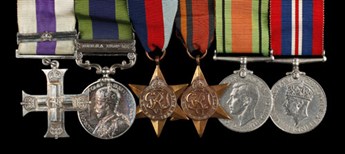 |
Britain's oldest Order of Knighthood is the Order of the Garter, which was founded way back in 1348. The official insignia of the Order is returnable on the death of the holder, and as a result rarely appears on the market. However, privately commissioned items, often considerably more decorative than the official insignia, do appear for sale from time to time. The finest example that I have seen is a sash Badge made by the Italian engraver and medallist Giovanni Santarelli, which was commissioned by the 5th Duke of Beaufort for use on the occasion of his Installation as a Knight of the Garter in May 1801. It is a beautiful item with a superb central onyx cameo of St. George slaying the dragon. Originally offered as part of the Beaufort Garter Jewels at Christie's in 1989, we sold it at auction on the 24th November 2005, where it graced the front cover of the sale catalogue, for a hammer price of £25,000 (£28,750 including Premium).
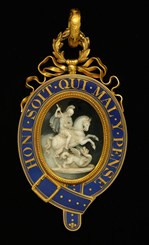 |
Undoubtedly the most attractive British decoration is the First Class Albert Medal. In April 2009 we sold the Albert Medal awarded to William Smith, Mate of the steam trawler the 'Crane' for gallantry in saving life at sea during the infamous 'Dogger Bank' incident in the North Sea, when the fishing fleet from Hull was attacked and shelled by the Imperial Russian Fleet. Two First Class Albert Medals were awarded for this action and, as often happens in the auction world, the success of the first medal, which sold for £15,000, led the second one onto the market. This Albert Medal was awarded to Arthur Rea, the Second Engineer from the 'Crane', who, despite being seriously injured, showed unyielding courage working in the engine room throughout the Russian bombardment, preventing the 'Crane's' boilers exploding until all were rescued. It is a beautiful medal and has an extraordinary story behind it, and in the end this sold in our auction on the 19th November 2009 for a hammer price of £17,000 (£20,400 including Premium).
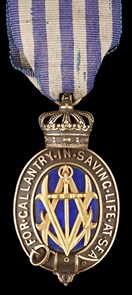 |
As well as dealing with mainly British medals we also sell a large selection of foreign orders, decorations, and medals. To choose just one out of the many hundreds that I have catalogued is most difficult, especially as a number of foreign orders, particularly those from Germany and Russia, combine to be rare, visually attractive, and highly sought-after- an auctioneer's dream! However, in our auction on the 21st April 2011 we sold a medal that was not only all of these things, but had the added bonus of being shrouded in mystery. This was the Chinese Gold Medal of Pao Hsing awarded in 1868 to Mr. William Cartwright of the Chinese Imperial Maritime Customs Service. Very little is known about these medals- instituted in 1862 as China's first official medal, and awarded for exceptional gallantry or distinguished service, awards of the medal ceased in 1881, and virtually no records regarding them exist. Researching exactly when and why it was awarded to Cartwright was an interesting and enjoyable challenge! Unsurprisingly it sold very well for a hammer price of £56,000 (£67,200 including Premium).
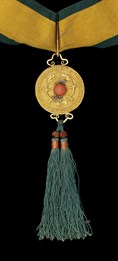 |
The final lot in my top ten is not actually a medal, but an item of Militaria- the Field Marshal's Baton bestowed upon Lord Grenfell. Grenfell had joined the Army as a Second Lieutenant in the King's Royal Rifle Corps in 1859, and 49 years later, in 1908, he was promoted to the top rank of Field Marshal. Almost two feet long, covered in purple velvet scattered with gold lions, and surmounted by a gold equestrian model of St. George slaying the dragon, Field Marshal's Batons rarely appear on the market- fewer than ten have appeared on the market since the Second World War. Although largely ceremonial, batons are sometimes used to direct troops in the field, and it is hard to think of a more inspiring way of soldiers being led than a Field Marshal rallying them on with his wand of office. Sadly the rank of Field Marshal has now been abolished, and it seems unlikely that another baton will ever be presented. We sold Lord Grenfell's Baton in our most recent auction on the 24th November 2011 for a hammer price of £45,000 (£54,000 including Premium).
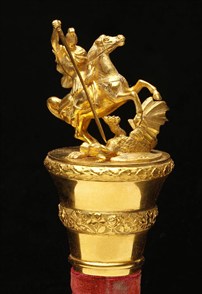 |
Some readers may have noticed that there is an absence in my top ten of any medals to the Royal Air Force. This is not a deliberate slight- merely an indication of the fact that most of the flying lots that we have sold have been catalogued by Mark, not me! However, I would like to 'Mention in Despatches' three great Second World War R.A.F. groups that we have sold at auction in which I did have a small role to play- those to Air Chief Marshal Sir Basil Embry, Group Captain Petrus Hugo, and Wing Commander Hugh Malcolm. Between them these three airmen were awarded one Victoria Cross, five Distinguished Service Orders, four Distinguished Flying Crosses, and one Air Force Cross. One of the services that we offer at Spink is to hand collect from anywhere in the world high value medal collections and single lots free of charge (something that our vendors appreciate, as the medals are fully covered by our insurance whilst in transit and we sort out all the customs paperwork). In collecting these three superb medal groups, from Australia, South Africa, and Canada, I was also fortunate to enjoy a bit of sun and some fantastic scenery in the process!



